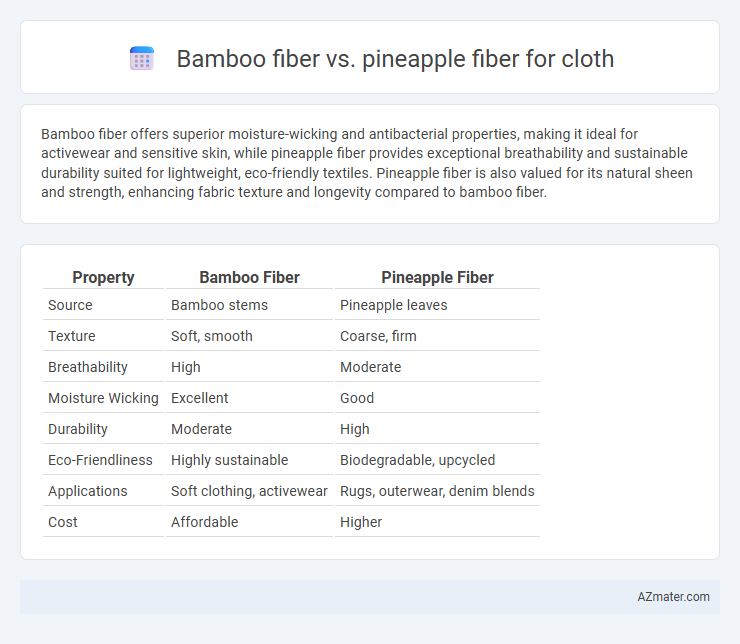Bamboo fiber offers superior moisture-wicking and antibacterial properties, making it ideal for activewear and sensitive skin, while pineapple fiber provides exceptional breathability and sustainable durability suited for lightweight, eco-friendly textiles. Pineapple fiber is also valued for its natural sheen and strength, enhancing fabric texture and longevity compared to bamboo fiber.
Table of Comparison
| Property | Bamboo Fiber | Pineapple Fiber |
|---|---|---|
| Source | Bamboo stems | Pineapple leaves |
| Texture | Soft, smooth | Coarse, firm |
| Breathability | High | Moderate |
| Moisture Wicking | Excellent | Good |
| Durability | Moderate | High |
| Eco-Friendliness | Highly sustainable | Biodegradable, upcycled |
| Applications | Soft clothing, activewear | Rugs, outerwear, denim blends |
| Cost | Affordable | Higher |
Introduction to Bamboo and Pineapple Fibers
Bamboo fiber, derived from the bamboo plant, is renowned for its softness, breathability, and natural antibacterial properties, making it highly suitable for sustainable and comfortable clothing. Pineapple fiber, obtained from the leaves of the pineapple plant, offers exceptional durability, lightweight texture, and eco-friendliness, commonly used in high-quality textiles and fashion. Both fibers are biodegradable and renewable, reflecting a growing shift towards environmentally responsible fabric alternatives in the textile industry.
Source and Extraction Process
Bamboo fiber is derived from the cellulose of bamboo plants through mechanical crushing and enzymatic treatment or chemical processes like viscose or lyocell methods, offering a sustainable and fast-growing source. Pineapple fiber, known as Pina, is extracted from the leaves of pineapple plants by hand scraping and retting, a traditional and labor-intensive process that utilizes agricultural waste. Both fibers emphasize eco-friendly raw materials, but their extraction varies from industrial chemical methods in bamboo to artisanal manual techniques in pineapple fiber production.
Environmental Impact and Sustainability
Bamboo fiber offers rapid growth rates and requires minimal pesticides, making it a highly sustainable option for cloth production with lower environmental impact compared to conventional fibers. Pineapple fiber, derived from agricultural waste (pineapple leaves), promotes zero-waste practices and supports circular economy models, enhancing sustainability through resource efficiency. Both fibers provide eco-friendly alternatives, but pineapple fiber's use of byproducts gives it a unique advantage in reducing environmental footprint.
Fiber Structure and Texture Comparison
Bamboo fiber consists of natural cellulose fibers that are soft, smooth, and highly breathable, making it ideal for lightweight, moisture-wicking clothing. Pineapple fiber, derived from the leaves of the pineapple plant, features a coarser, stiff texture with a unique fiber structure that provides durability and a slightly rougher feel, suitable for more structured garments. The microscopic arrangement of bamboo fibers yields a finer, silkier fabric texture, while pineapple fibers produce textiles with greater rigidity and a natural, rustic appearance.
Comfort and Breathability
Bamboo fiber offers superior moisture-wicking properties and natural antibacterial benefits, enhancing comfort and breathability in clothing. Pineapple fiber, derived from pineapple leaves, provides a lightweight and breathable fabric but tends to be less soft and flexible than bamboo fiber. Both fibers are sustainable alternatives, with bamboo excelling in softness and moisture management, while pineapple fiber delivers durability and eco-friendliness.
Durability and Longevity
Bamboo fiber exhibits remarkable durability due to its natural strength and antimicrobial properties, making it resistant to wear and tear over time. Pineapple fiber, also known as pina, is highly durable with a lightweight yet strong structure that maintains fabric integrity even after multiple washes. Both fibers offer excellent longevity, but bamboo's flexibility and moisture-wicking capabilities often provide enhanced long-term comfort and resilience in clothing.
Dyeability and Color Retention
Bamboo fiber exhibits excellent dyeability due to its porous structure, allowing for vibrant and consistent color absorption, while retaining color well after multiple washes. Pineapple fiber, though naturally coarse, accepts dyes moderately but tends to have less color retention compared to bamboo, often resulting in faster fading over time. Both fibers benefit from eco-friendly, low-impact dyes, but bamboo fiber remains superior for achieving long-lasting, rich hues in textile applications.
Cost and Market Availability
Bamboo fiber is generally more affordable than pineapple fiber due to its faster growth rate and larger-scale commercial farming, making it widely available in global textile markets. Pineapple fiber, also known as Pina, is more expensive and less common because it requires labor-intensive extraction from pineapple leaves, limiting its availability primarily to niche and luxury clothing sectors. Market demand favors bamboo fiber for cost-effective, eco-friendly fabrics, while pineapple fiber is valued for high-end, artisanal garments with limited production.
Applications in Textile Industry
Bamboo fiber offers exceptional softness, breathability, and moisture-wicking properties, making it ideal for activewear, casual clothing, and eco-friendly textiles. Pineapple fiber, known as Pina, provides a lightweight, durable, and lustrous texture commonly used in high-end fashion, traditional garments, and upholstery fabrics. Both fibers contribute to sustainable textile production but cater to different market segments due to their unique tactile qualities and processing techniques.
Choosing the Right Fiber for Your Needs
Bamboo fiber offers softness, breathability, and natural antibacterial properties, making it ideal for sensitive skin and activewear, while pineapple fiber, derived from sustainable pineapple leaves, provides a strong, lightweight, and biodegradable option perfect for durable and eco-friendly textiles. When choosing the right fiber, consider bamboo for moisture-wicking and comfort in everyday garments, whereas pineapple fiber suits premium fashion or upholstery requiring resilience and texture. Evaluating factors like environmental impact, fiber strength, and fabric end-use ensures selecting the optimal material tailored to specific clothing needs.

Infographic: Bamboo fiber vs Pineapple fiber for Cloth
 azmater.com
azmater.com